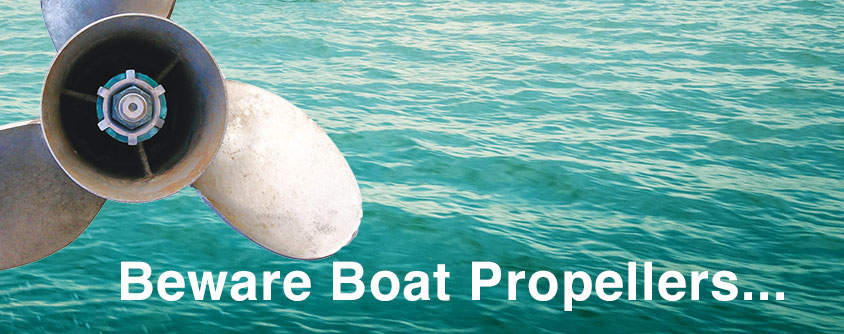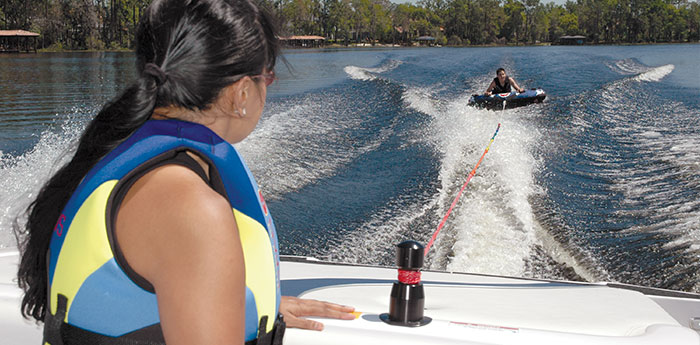
For fun that lasts, think safety first
Attention:
Swimmers • Skiers • Tubers • Anglers • Wake Boarders • All Boaters
SAFETY TIPS
- People in the water may not be visible from the helm. Before starting your engine, walk around the boat and look in the water to make certain that no one is in the water near the boat.
- Account for all of your passengers prior to starting the engine.
- Never allow passengers to board or exit your boat from the water when engines are on or idling because the propeller may continue to spin.
- Educate passengers about the location and danger of the propeller(s), and call attention to any propeller warning labels on your boat.
- Be especially alert when operating your boat in congested areas and never enter swimming zones.
- Be extra vigilant near boats that are towing skiers or inflatables.
- Never permit passengers to ride on the bow, gunwale, transom, seatbacks or other locations where they might fall overboard. This practice is extremely dangerous and AGAINST THE LAW!
- Keep passengers inside the railings of pontoon boats while underway.
- Ensure each passenger is in a designated occupant position. Move passenger positions to suit water conditions. Insist all passengers use available handholds while the boat is underway.
- To prevent falls overboard, children should be supervised by a designated adult while onboard the boat.
- Establish clear rules for use of the swim platform and boarding ladders. Never use the swim platform or boarding ladder when the engine is on.
- If someone falls overboard, slow the boat and then slowly turn the boat back around. Assign a passenger to continuously monitor the person in the water. For maximum visibility, keep the person in the water on the operator’s side of the boat. Turn your engine off FIRST and then allow the person to swim back to the boat.
- Never put your boat in reverse to pick someone up out of the water; instead circle around again.
SAFETY INFORMATION
For safety information, visit the U.S. Coast Guard Office of Boating Safety web page: uscgboating.org
“Take your valuable driving experience and overall concern for your passengers’ safety from your car to your boat. Just as when you buy a car, ask your boat dealer for a list of safety devices. In addition, take a boating safety course. Safe boating education supported by technology will help prevent propeller strikes.”
—Keith Jackson, President
MariTech Industries
MariTech Industries
UNDERSTAND THE DANGER OF PROPELLER STRIKES
DID YOU KNOW?
- A typical three-blade propeller running at 3,200 rpm can strike 160 times in one second, and can travel from head to toe on an average-size person in less than one-tenth of a second.
- Accidental falls overboard are a leading cause of propeller-related accidents.
- Most propeller accidents CAN be prevented!

WHAT CAN YOU DO?
- Be aware of what is going on around you! The captain of the boat is in command and must take responsibility for the safety of people in and around the boat.
- Always wear your ignition cut-off switch lanyard. If the lanyard is pulled from the switch, the engine will shut off allowing the propeller to slow rapidly and then stop.
- Always assign a passenger to keep watch around the propeller area of your boat when people are in the water.
- Wear your life jacket and instruct all passengers to do the same.
- Read and follow all the safety instructions in your boat and engine operator’s manuals.
- Have your boat’s steering system inspected annually by a certified technician for signs of premature wear.
If the driver is thrown overboard or moves away from the boat’s controls, an ignition cut-off switch lanyard will shut off the engine allowing the propeller to rapidly slow, then stop rotating.
Taking a boating safety course is the best way to prepare for a safe and enjoyable time on the water. For more information, go to uscgboating.org As a boat owner or operator, you are responsible for your safety and for the safety of your passengers.
Boat Responsibly!
National Marine Manufacturers Association
231 S. LaSalle Street, Suite 2050
Chicago, IL 60604
nmma.org
231 S. LaSalle Street, Suite 2050
Chicago, IL 60604
nmma.org
This brochure is published by NMMA for educational purposes only and it should not be assumed that all relevant safety information is included herein. NMMA makes no guarantee, representation or warranty, express or implied, at law or in equity, as to the validity, accuracy or sufficiency of the information included in this brochure. NMMA assumes no responsibility or liability for any injuries, claims, losses or damages arising in connection with the use of or reliance on the information included in this brochure.
POWERED BY 
